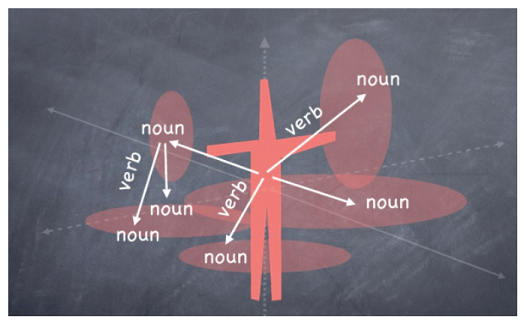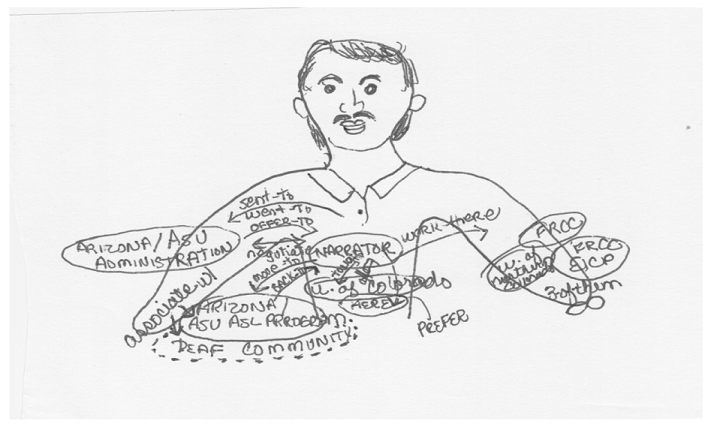 Spatial map of a signer" width="524" height="326" />
Spatial map of a signer" width="524" height="326" />This guide enhances general interpreting skills by exploring spatial mapping of verbs and providing activities to improve verb agreement and distribution. Resources that include ASL and English narratives are provided below.
Learners can practice tracking verbs in ASL messages by creating spatial maps.
The strategy of spatial mapping involves the following steps:
Here is an image of what the end result might look like. This graphic only shows the verbs going in one direction - from the signer to the zone. However, in many texts, the verbs will also move from the zone to the signer.

Try mapping an ASL text and apply this process. View the following ASL video (2:10 minutes in length). In the video, the signer - Tom Riggs - is discussing a relocation from one state to another due to a job. Don’t be overly concerned about the specific details - such as the universities he names or the states involved. Instead, focus on how he organizes information in space, and specifically the verbs he uses. Chart the main spaces and the direction of verbs to and from those spaces.
TR Work Relocation
posted by Anna Witter-Merithew
~2 minutes in length
When you are finished, you should have a mapping that looks something like this.

What verbs did you identify? How do your findings fit with the list that follows?
Examples of Verb Agreement
Examples of Spatial Verbs
View the text as often as you would like until you feel confident that you are able to see each of the specific zones / areas and what is referenced in each, the verbs that show action from him as the narrator to that zone / area and from that zone / area to him, as well as the spatial verbs.
Then, generate an interpretation of the text. Practice it a few times until you are satisfied you have a solid representation of the information. Then, conduct a self-assessment of your performance. Were you successful in accurately interpreting the verbs and maintaining the appropriate agreement? Where could you make improvements? Seek feedback from a mentor and/or peer as well. Use this feedback, along with your own assessment, to re-do the interpretation.
Repeating this process with a variety of texts will heighten your awareness of verb forms and verb agreement in ASL. This can strengthen your ASL to English interpretations.
Apply the steps outlined in Exercise A to a new ASL text.
Sign with Robert - New Used Car Story
posted by Hilari Scarl
~3 minutes in length
Step 1. Watch the ASL text.
Step 2. List the main ideas of the text.
Step 3. Map the spatial structuring that occurs in the text.
What zones / areas are used around the signer’s body? What information is established in the zones / areas? What directional and spatial verbs are used? How do they relate from the signer to the zone / area or from the zone / area to the signer?
Review the completed map to identify the inter-relatedness of ideas and how the overall message fits together.
Step 4. Record yourself interpreting the text, applying cross-linguistic features to convey the verb forms in spoken English.
Review your performance against the spatial map and assess your effectiveness in conveying all the intended connections. Are there areas where you could improve your performance as it relates to verb forms as part of spatial structuring? If so, where and why?
Step 5. Seek feedback from a peer and/or mentor. Incorporate this feedback, along with your own observations from the self-assessment, and re-do your interpretation.
Step 6. Apply steps 1-5 to a range of ASL texts involving different speakers and a variety of topics.
NOTE: These resources were last updated March 2021.